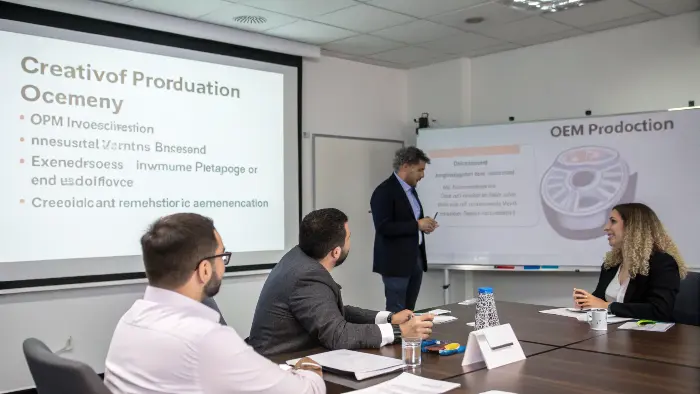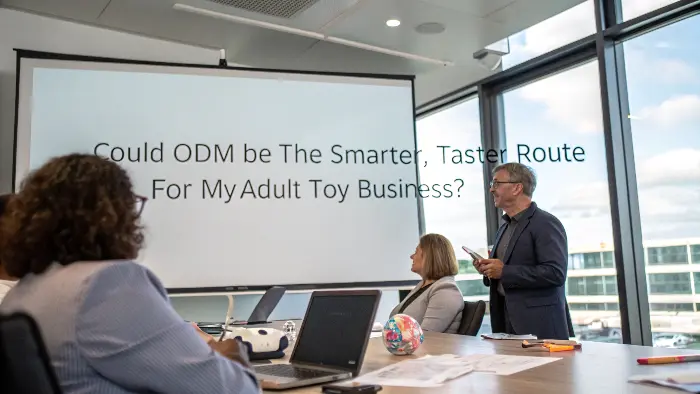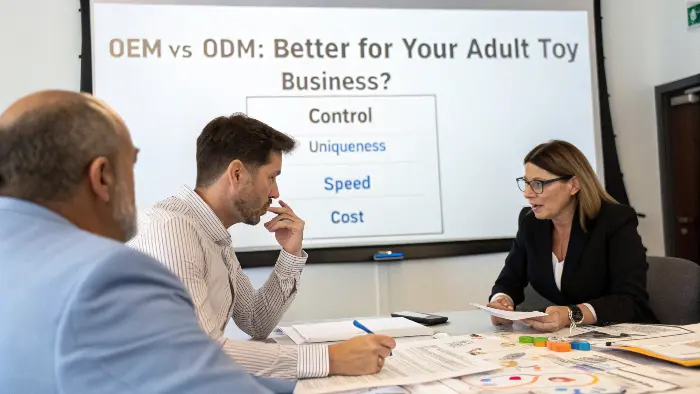Stuck choosing between OEM and ODM for your adult toys? It’s a big decision, confusing even. What if you pick the wrong path and regret it later?
In adult toy manufacturing, OEM (Original Equipment Manufacturer) offers full design control, while ODM (Original Design Manufacturer) means faster production and lower costs with less design input. Your choice depends on your business needs, budget, and how much control you want.
Transition Paragraph:
Navigating the manufacturing world can feel like a maze, especially when you’re trying to bring your unique vision for adult products to life. I’ve been there, staring at these acronyms – OEM, ODM – wondering what they really mean for my brand, PrivyPlay, and for entrepreneurs like you. It’s not just alphabet soup; this choice fundamentally shapes your product, your brand identity, and even your bottom line. So, let’s break it down, get into the nitty-gritty, and figure out which route is the best fit for your ambitions. Trust me, understanding this is a game-changer.
What’s the Real Difference Between OEM and ODM in the Adult Toy World, Anyway?
| You hear "OEM" and "ODM" thrown around, but what’s the actual, practical difference when we’re talking pleasure products? It can seem like just industry jargon, making it hard to see what matters for your specific brand. OEM means you provide the full design, and the factory builds it. ODM means you pick from the factory’s existing designs, maybe with some tweaks. Think custom-built versus off-the-rack with alterations for your adult toy line. ! Dive deeper Paragraph: Let’s get down to brass tacks. When I first started looking for manufacturing partners for PrivyPlay, the OEM/ODM distinction was a bit of a head-scratcher. But it boils down to this: OEM (Original Equipment Manufacturer) is like commissioning a bespoke suit. You – the brand owner – come with a complete, detailed design. This includes everything: the exact shape, materials, specific motor inside, the color, the packaging, the whole shebang. The factory then takes your blueprint and manufactures the product for you, to your exact specifications. You own the intellectual property (IP) of that design. This path is awesome for brands that have a super unique product idea, something nobody else has, and want total control over every little detail. I remember working on a very specific ergonomic design for one of our early toys; OEM was the only way to ensure it was made precisely as we envisioned. It took longer, sure, but the result was ours. ODM (Original Design Manufacturer), on the other hand, is more like picking a fantastic dress off the rack and maybe having the hemline adjusted or a different color ordered. The factory already has a range of product designs developed in-house. You browse their catalog, select a product that’s close to what you want, and then you can usually request some modifications – like your brand’s logo, different colors, or specific packaging. The core design, however, belongs to the factory. This is often quicker and cheaper because the R&D and tooling costs are already absorbed by the manufacturer. Many brands start here, especially if they want to test the market quickly. It’s a solid way to get products out there without a massive upfront investment in design. We’ve even used ODM for some accessory items where speed to market was key. Here’s a simple table to make it clearer: |
Feature | OEM (Original Equipment Manufacturer) | ODM (Original Design Manufacturer) |
|---|---|---|---|
| Design Origin | Your brand provides the full design | Factory provides existing designs | |
| IP Ownership | Your brand owns the design IP | Factory usually owns the core design IP | |
| Customization | Total, down to the smallest detail | Limited to aesthetics, packaging, branding | |
| R&D Cost | Borne by your brand | Borne by the factory (or lower for you) | |
| Tooling Cost | Usually paid by your brand | Often included or lower | |
| Time to Market | Longer | Shorter | |
| Minimum Order | Often higher | Can be lower |
Understanding these fundamental differences is the first step to making the right call. It’s not about which one is "better" overall, but which one is better for you right now.
When Does Going Full OEM Make the Most Sense for My Adult Toy Brand?
So, you’re dreaming of a truly unique product, something groundbreaking for your customers. But OEM sounds like a lot of work and money. Is it really the best path when you’re aiming for something special in the adult toy market?
OEM is ideal when you have a highly innovative and specific product design, want complete control over quality and features, and aim to build strong brand differentiation with unique intellectual property. It’s for brands ready to invest more for a truly custom offering.

Dive deeper Paragraph:
Going the OEM route is a big commitment, no doubt about it, but for certain brands and product visions, it’s absolutely the way to go. I’ve seen brand owners, especially fellow e-commerce entrepreneurs in the wellness space, opt for OEM when they have a game-changing idea. Think about it: if you’ve identified a gap in the market, a specific need that current products aren’t meeting, or you’ve conceived a toy with a truly novel function or aesthetic, OEM allows you to bring that exact vision to life. You’re not compromising. You are the architect. This was exactly our thinking at PrivyPlay when we developed our flagship [Product Line Name – placeholder for client to fill] series; the specific contours and internal mechanisms were so unique, only OEM could deliver.
The biggest draw for OEM is total control. You dictate the materials (crucial for body-safe, high-quality toys!), the components, the performance specs, and the overall quality. This means you can ensure your product truly reflects your brand’s promise of "Elevating Pleasure, Empowering Confidence." If you’re building a premium brand, this level of control is non-negotiable. Another massive advantage is Intellectual Property (IP) ownership. The design is yours. This is huge for building long-term brand value and defending against copycats. Imagine spending years developing a unique feature, only to have someone else easily replicate it because you went an ODM route where the core IP wasn’t yours. Nightmare, right? OEM protects your innovation.
However, you gotta be prepared. OEM usually means higher upfront costs for R&D, mold making (tooling), and potentially higher MOQs. It also takes longer to go from concept to market. You’ll be deeply involved in the development process, back and forth with engineers, prototypes – it’s a journey. I remember the countless hours we spent on [specific design challenge story placeholder – e.g., perfecting the vibration pattern on a new model]. It was intense, but when we finally held that perfect prototype, it was all worth it. So, if you have a strong, unique concept, the budget, the time, and a desire to build a truly distinct brand, OEM is likely your champion. It’s for visionaries who want to create, not just sell.
Could ODM Be the Smarter, Faster Route for My Adult Toy Business?
You want to get your adult toy brand off the ground or expand your line quickly, but the thought of extensive R&D and high OEM costs is daunting. Could ODM be a more practical, even clever, way to achieve your goals without breaking the bank or waiting ages?
ODM is often smarter and faster if you need to launch products quickly, have a limited budget for R&D and tooling, or want to test market demand for certain types of adult toys before investing heavily in unique designs. It offers a lower barrier to entry.

Dive deeper Paragraph:
Let’s be real, not every brand, especially when starting out or looking to diversify quickly, has the resources or the burning need for full-blown OEM on every single product. That’s where ODM really shines. Think of it as a launchpad. For PrivyPlay, while our core innovative products are OEM, we’ve strategically used ODM for certain complementary items or when we wanted to test a new product category without massive upfront risk. It’s a very pragmatic approach. The biggest win with ODM is speed to market. The manufacturer has already done the heavy lifting on design, engineering, and often initial tooling. You’re essentially picking from a pre-vetted menu. This means you can go from selecting a product to having it ready for sale in a fraction of the time OEM would take. I’ve seen sourcing managers get products to market in just a few months using ODM – that’s fast!
Then there’s the cost factor. Because the manufacturer has developed the product, they’ve absorbed most of the R&D and tooling expenses, often spreading them across multiple clients. This translates to lower startup costs for you. Your investment is mainly in inventory and any customization like branding, packaging, or color changes. This is incredibly helpful for e-commerce entrepreneurs who need to manage cash flow carefully. MOQs (Minimum Order Quantities) can also be lower with ODM, which is another bonus if you’re testing the waters or have limited warehousing. For instance, we wanted to introduce a simple [accessory type, e.g., a satin storage bag] with our branding. Going ODM for this was a no-brainer; it was quick, cost-effective, and got the job done beautifully.
Of course, the trade-off is less differentiation. Your product might look similar to others on the market if other brands are sourcing from the same ODM catalog. And you don’t own the core design IP. But for many businesses, especially those focusing on building a strong brand through marketing, customer service, and curating a specific vibe, this is an acceptable compromise, particularly for entry-level or mid-range products. You can still create a strong brand identity through your unique packaging, marketing story, and the overall customer experience. It’s about being smart with your resources. If your priority is getting quality products into your customers’ hands quickly and affordably, ODM is a very compelling option.
So, Which is Actually "Better," OEM or ODM, for My Goals?
Okay, we’ve picked apart OEM and ODM. But at the end of the day, you need to make a choice. Is one definitively superior, or does it truly boil down to what your adult toy business is trying to achieve right now?
Neither OEM nor ODM is inherently "better"; the "best" choice depends entirely on your brand’s specific strategy, resources, risk tolerance, and product goals. Analyze your priorities for control, uniqueness, speed, and cost to decide.

Dive deeper Paragraph:
This is the million-dollar question, isn’t it? And the honest answer is: it depends. There’s no universal "better" here. What’s perfect for one brand might be a disaster for another. As a brand owner at PrivyPlay, I’ve had to make this call multiple times, and it always comes back to our specific goals for that particular product or that stage of our business. If our goal is to launch something utterly groundbreaking, a true flagship that defines our commitment to "Elevating Pleasure," then OEM is our champion, despite the higher investment. We need that control, that IP ownership. I recall a sourcing manager I know who built an entire successful brand around a single, very unique OEM product – it became their hero.
But if the goal is to quickly expand our range with a reliable, good-quality product that fills a more standard niche, or to test a new market segment without betting the farm, ODM becomes incredibly attractive. The speed and lower cost can be exactly what’s needed. Many wellness brand founders I’ve talked to use ODM to get their initial product line out, build cash flow, and then reinvest in OEM projects later. It’s a smart stepping stone.
Think about these factors for your business:
- Uniqueness & Innovation: How critical is it for this product to be 100% unique? If very, lean OEM.
- Budget: What are your R&D, tooling, and per-unit cost constraints? ODM is usually more budget-friendly upfront.
- Time to Market: How quickly do you need to launch? ODM wins on speed.
- Control: How much say do you need in every design and quality detail? OEM offers max control.
- IP Ownership: Is owning the design IP a strategic priority? If yes, OEM is crucial.
- Risk Tolerance: Are you comfortable with higher upfront investment and longer development (OEM), or do you prefer lower risk and faster validation (ODM)?
Sometimes, a hybrid approach can even work. Perhaps an ODM base with more significant OEM-level customization. The key is to have honest conversations with potential manufacturers like us at PrivyPlay. We understand the nuances and can help guide you based on your vision, whether it’s developing a custom toy from scratch or finding the best ready-to-brand solutions. It’s about finding the right partnership to bring your brand’s unique promise to your customers. So, instead of "better," ask "better for me, right now?" That’s the real question.Conclusion
Choosing between OEM and ODM manufacturing for your adult toys isn’t about right or wrong. It’s about aligning with your brand’s unique vision, resources, and market strategy. Understand the pros and cons to make the best choice.
